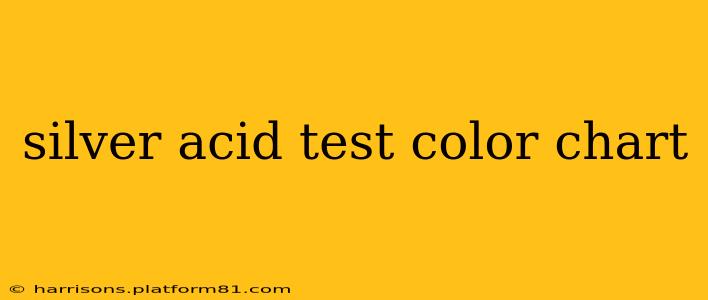The silver acid test, also known as the nitric acid test, is a crucial method for identifying genuine silver. By observing the reaction of silver with nitric acid, one can determine its purity. However, simply observing the reaction isn't enough; understanding the resulting color changes and what they signify is key. This guide provides a comprehensive overview of the silver acid test color chart and explains the nuances of interpreting the results.
What is the Silver Acid Test?
The silver acid test involves dissolving a small sample of silver in concentrated nitric acid (HNO₃). Genuine silver will react with the acid, producing a distinctive color change. This reaction is a chemical process where silver (Ag) is oxidized and dissolves to form silver nitrate (AgNO₃), a soluble salt. The resulting solution's color indicates the silver's purity. This is a destructive test; the silver sample is consumed during the process.
The Silver Acid Test Color Chart: Understanding the Nuances
It's important to understand that there isn't a single, universally accepted "color chart" for the silver acid test. The color of the resulting solution depends on several factors including the concentration of the nitric acid, the purity of the silver, and the presence of other metals in the alloy. However, we can outline the general color interpretations:
Clear to Light Greenish Solution:
This usually indicates high-purity silver. The solution might appear almost colorless, or a very pale green. The clearer the solution, the higher the likelihood of the silver being very close to 99.9% pure.
Dark Green Solution:
A dark green solution usually suggests the presence of copper in the silver alloy. Copper reacts with nitric acid to produce a green solution. The darker the green, the higher the likely copper content.
Bluish-Green Solution:
A bluish-green hue often points towards the presence of other base metals, besides copper, in the silver alloy. This necessitates further testing to identify the specific alloy composition.
Brown or Dark Brown Solution:
This is usually a sign of impurities. It indicates that the silver sample contains a significant amount of other metals that react with nitric acid to produce brown-colored compounds. This is a definite indication of low purity.
No Reaction/No Color Change:
If there's no apparent reaction or color change, it's possible the item isn't silver, or it's coated with another metal. Further investigation with other testing methods is required.
What if I get an Unexpected Color?
The color variations encountered during the silver acid test can be complex and sometimes unpredictable. If the resulting color doesn't neatly fit into the categories above, it's crucial to consult a professional gemologist or metallurgist for a precise analysis. They can use more sophisticated methods to determine the exact composition of the metal.
Frequently Asked Questions (PAAs)
Is the silver acid test reliable for all types of silver?
While the acid test is a useful tool, it's not foolproof. It works best for detecting the presence of base metals in silver alloys. It won't distinguish between different forms of pure silver (e.g., sterling silver versus fine silver). The presence of certain plating or coatings might also interfere with accurate results.
What safety precautions should I take when performing the silver acid test?
Nitric acid is a corrosive and potentially dangerous chemical. Always wear appropriate safety goggles, gloves, and work in a well-ventilated area. Dispose of the acid waste responsibly according to local regulations.
Can I use other acids instead of nitric acid for the silver acid test?
While nitric acid is the most common acid used for the silver test, other acids may react differently or not at all. Nitric acid is particularly effective because it dissolves silver readily and produces distinctive color changes.
What are the limitations of the silver acid test?
The silver acid test is a qualitative test, not a quantitative one. It indicates the presence of impurities but doesn't provide the precise percentage of each metal in the alloy.
What other methods can I use to test for silver?
Other methods for testing silver include X-ray fluorescence (XRF) spectroscopy, which provides a precise elemental analysis, and hallmarking, where the item's markings indicate its silver content.
This comprehensive guide provides valuable information about the silver acid test and its color interpretations. Remember, safety is paramount when handling nitric acid. Always prioritize safety precautions and consider consulting a professional for accurate results, especially when dealing with valuable or antique items.
